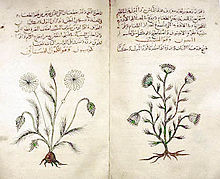Medicinal plants are widely used in non-industrialized societies, mainly because they are readily available and cheaper than modern medicines. The annual global export value of the thousands of types of plants with medicinal properties was estimated to be US$60 billion per year and it is growing at the rate of 6% per annum. In many countries, there is little regulation of traditional medicine, but the World Health Organization coordinates a network to encourage safe and rational usage. The botanical herbal market has been criticized for being poorly regulated and containing placebo pseudoscience products with no scientific research to support their medical claims.[3] Medicinal plants face both general threats, such as climate change and habitat destruction, and the specific threat of over-collection to meet market demand.[3]
History[edit]
Prehistoric times[edit]
Plants, including many now used as culinary herbs and spices, have been used as medicines, not necessarily effectively, from prehistoric times. Spices have been used partly to counter food spoilage bacteria, especially in hot climates,[5][6] and especially in meat dishes which spoil more readily.[7] Angiosperms (flowering plants) were the original source of most plant medicines.[8] Human settlements are often surrounded by weeds used as herbal medicines, such as nettle, dandelion and chickweed.[9][10] Humans were not alone in using herbs as medicines: some animals such as non-human primates, monarch butterflies and sheep ingest medicinal plants when they are ill.[11] Plant samples from prehistoric burial sites are among the lines of evidence that Paleolithic peoples had knowledge of herbal medicine. For instance, a 60,000-year-old Neanderthal burial site, "Shanidar IV", in northern Iraq has yielded large amounts of pollen from eight plant species, seven of which are used now as herbal remedies.[12] Also, a mushroom was found in the personal effects of Ötzi the Iceman, whose body was frozen in the Ötztal Alps for more than 5,000 years. The mushroom was probably used against whipworm.[13]
You received this message because you are subscribed to the Google Groups "1TopReadys1" group.
To unsubscribe from this group and stop receiving emails from it, send an email to 1topreadys1+unsubscribe@googlegroups.com.
To view this discussion on the web visit https://groups.google.com/d/msgid/1topreadys1/CAEXU47W6-O2sBQnhuYS6DdB-vFkrrc5DEYoTnHsRSxYSikGTjA%40mail.gmail.com.

No comments:
Post a Comment